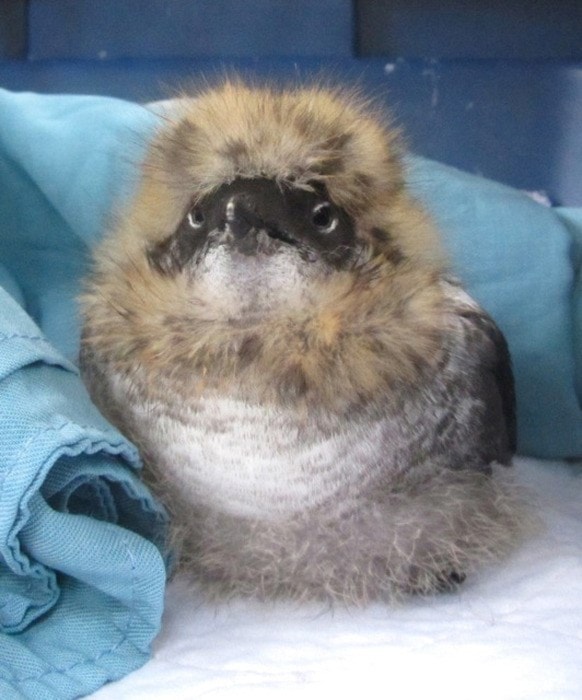Why would a bird make a round trip twice a day to carry fish back to an inland nest 60 kilometres away from the ocean to feed its chick?
Only the marbled murrelet can answer that question. Not only is the journey a dangerous one, it is also a solitary venture.
Murrelets are small, fast-flying members of the auk family of sea birds. There are four species of murrelets found along the North American Pacific coast.
The marbled murrelet is found from the Aleutian Islands to the central Californian coast. These little birds breed along the west coast of British Columbia and especially in the remote sounds and inlets along Vancouver Island's west coast.
During the summer months their speckled breeding plumage provides them with a "marbled" appearance. As fall approaches they undergo a full body and wing moult that provides them with white bellies and dark underparts that makes them less conspicuous against the dark water.
Marbled murrelets are small sea birds with slender black bills, short stubby tails and tiny black webbed feet. They can be easily identified by their white throats and horizontal stripes on their wings when folded back.
Marbled murrelets have many unique features that set them apart from the other auks and their secretive, solitary nature has proven to be a challenge for biologists who are studying their behaviour and trying to unlock the key to their secrets.
Their choice of nesting sites is very specific and very hard to locate and study. Old-growth forested areas are critical for these birds to nest successfully and they do not return to the same nest each year, meaning they need a wider habitat to breed.
Some nest sites are miles from the ocean in the forest and located several feet above the ground on a moss-covered branch, unlike other members of the auk family that nest in the open on remote islands in colonies.
These little birds are unable to launch into flight from the land. They use their tiny feet to paddle on the water before diving in pursuit of their food. They use their wings to propel themselves through the water, and will often hunt co-operatively, herding the fish into a ball and pushing it up closer to the surface.
Breeding usually results in the production of one large green-tinted egg well-camouflaged against the green moss.
Marbled murrelets take twice as long to rear their chicks before they are ready to fledge. They must be fully developed and capable of sustained flight before they attempt to leave the nest.
Their first flight is their only chance to survive as their path takes them directly to the ocean. Sadly, many don't make it. I continue to be in awe of the tenacity and fortitude shown by different wildlife species.
This year, MARS has cared for some cases that have beaten the odds after sustaining life-threatening injuries. For one tiny little bird his story started on an unpaved dusty road between Tahsis and Gold River.
His rescuer was en route to Campbell River on a busy day for tourists and logging trucks. Uncertain by what she saw, the driver managed to turn around and relocate the tiny fluff ball that was still in one piece on the side of the road. She put the bird in a camera bag to keep it safe and continued on her journey.
She had heard of our centre and after two and a half hours arrived with the bird, having no idea she had rescued one of B.C.'s "species at risk."
To conclude the story, the murrelet grew rapidly and was sent to the Wildlife Rescue Association in Vancouver, where it was tested in a large pool for diving, swimming and waterproofing.
Passing all the tests and being banded, it made the round trip by helicopter (thanks to Norm Snihur) back to MARS. The bird was then transported by a boat that was taking naturalist volunteers for their weekly duties on Mittlenatch Island, off Campbell River.
The murrelet was released close to a group of other marbled murrelets. Hopefully they will take over teaching survival skills to the orphaned bird.
The future of these birds is certainly in doubt; of great concern is the loss of the old-growth habitat and trees for nesting.
In recent years many have perished by drowning after being caught in gill nests set to capture salmon. They have also been victims of small oil spills, but the threat of a major spill would be catastrophic for their populations.
We wish our little murrelet a safe return to the wild and thank Cindy, who took the time and effort to save one tiny creature.
• • •
Now is a great time to get out bird watching. The fall migration has started and I am sure there will be many more unusual sightings.
Please respect migratory birds along our shorelines. This is a critical time for them to fatten up for their long journey south.
To report injured bids or to get advice, call 1-800-304-9968. For general information, visit www.wingtip.org.
Sandy Fairfield is the educational co-ordinator for the Mountainaire Avian Rescue Society (MARS). The MARS column appears every second Friday.
